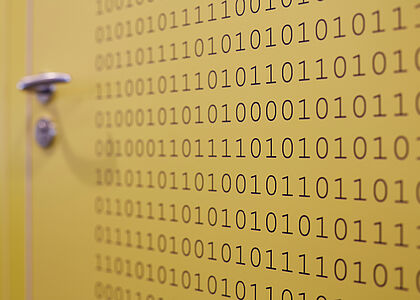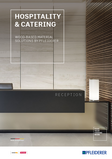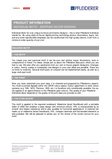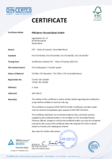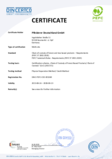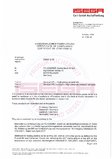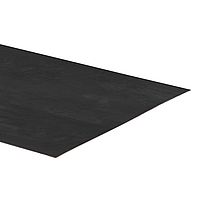Availability
Overview of available formats
| Length (mm) | Width (mm) | Thickness (mm) |
|---|---|---|
| 2,800 | 2,070 | 1.2 |
Certificates & labels
Product features
Areas of application
- Wherever high demands are made on quality and durability in addition to preventive fire protection in decorative interior design. For wall coverings, installations and interior furnishing in industrial, sales and administration buildings, in recreational facilities and public areas, such as schools, sports and festival halls, cinemas, discotheques, hotels, hospitals and care home facilities.
Product standard
- In accordance with EN 438-3
Density
- Min. 1,350 kg/m³
Reaction to fire
- Flame retardant
- C-s1,d0 (EN 13501-1)
- Depending on the core material and adhesive used, HPL bonded boards may have a different classification. We recommend the use of the product Duropal Element Pyroex.
Formaldehyde emission class
- E1 E05
Antimicrobial effect
- Surface with antimicrobial effect in 24 h for interior fit-out and finishes – Test Methodology JIS Z 2801 / ISO 22196
Product safety
- This product follows the REACH regulation EC 1907/2006 an article. Following Article 7 it does not need to be registered.
- The surface is physiologically safe, and approved for direct contact with food acc. to Regulation (EU) No. 10/2011.
- The decorative surface and the core consists of paper layers, which are impregnated with thermosetting resins. The resins harden completely during the manufacturing process by heat and high-pressure. They form a stable, resistant and non-reactive material.
Special
- Maximum motif format per board, incl. overprinting: 2,750 x 2,030 mm. Larger motifs can be tiled.
- Cut to size is not available.
- Colour differences can occur in follow-up production lots.
- FSC certification or PEFC certification available on request.
Colour and surface match
- Decor, structure and core board all influence the final appearance of the end product.
- Due to the product-specific differences in production technologies, even identical decor/structure/core board combinations can result in slight optical and tactile deviations across different product groups and formats. Such deviations do not constitute a defect.
- The choice of surface structure in particular has a significant influence on the visual impression, the tactile perception as well as the technical characteristics of the product. Thus, the overall impression of a decor can change almost completely depending on the surface structure. Furthermore, mechanical influences on the product surface can lead to a higher contrast optical perception with dark decors.
- To ensure that you always achieve the best results with our products and to clarify any deviations in advance, we will be happy to advise you individually.
Additional information
Product handling
Processing
- Please consider that digital printed laminates are, because of their material composition, slightly harder and more brittle than classical laminates.
- If possible, each motif is produced around the circumference with an overfill of approx. 15 mm and accordingly cutting marks are set.
- The motif cutting marks are not binding; therefore, each motif format must be checked before cutting to size.
- Sawing or formatting the boards in a stack is not possible.
- Assignment of the motifs parallel with the edge of the coreboard is not possible for production reasons.
- Sufficient conditioning is required prior to installation and assembly. The premises themselves need to be at the normal climatic conditions in which the material will later be used.
- For an optimum result when cutting to size we recommend the following measures:
- Use a universal saw blade with chamfer (WZ/FA), e.g. GlossCut sawblade made by Leitz
- Hollow ground or trapezoidal tooth sawblades with negative tooth angle
- Optimized height adjustment of the sawblade
- Use universal scoring unit
- Use e.g. a pressure bar or pressure strip to prevent vibration of the material
- Work with lower feed rate than for standard laminates - Use a flat, firm surface to saw and drill on.
- Please note that sharp curring and quiet running tools are indispensable for perfect results.
- Drillholes must be countersunk. Through holes must be made oversize.
- Cutouts and inside corners must have a minimum radius of 8 mm to prevent notch stresses and therefore possible subsequent formation of cracks.
- To avoid chatter marks, cutting tools with high true-running are required. The feed rate is to be reduced in edge-corner and interface areas.
- An „Individual Backing HPL" is required to produce a composite element. If another backing material is used, there is a risk of warping.
- Please respect the recommendations of BLFA (www.blfa.co.uk) an ICDLI (www.icdli.com) for the processing of high-pressure laminates.
- We recommend carrying out your own tests depending on the respective application and material requirement.
Machines and tools
- Can be worked with carbide (HW) or diamond (DP) tipped tools on conventional woodworking machines.
- Keyhole saws, punches and jars are not suitable.
Installation and assembly
- The material is not suitable for areas subject to large fluctuations in temperature and humidity.
- Make sure that expansion of installed elements is not prevented. Please observe that when panels are combined with other materials their coefficients of expansion may differ.
- Ensure adequate room for movement of the panel material in the installed condition. Panel joints are to be made with oversize joints and throughholes.
- Avoid direct exposure to heat and any possible dehydration of the surfaces by light- or heat radiation or by air currents from heating- or air conditioning systems.
- Please ensure that the material is processed and fitted correctly and using the best available technology.
- For further information on processing and installation of HPL and compact HPL, please respect the recommendations of ICDLI (www.icdli.com).
Storage, handling and transport
- The material must be stored flat, level and horizontal on clean surfaces at normal climatic conditions (Temperature 18–25 °C, relative humidity 50–65 %).
- Avoid storage in the direct vicinity of thoroughfare gates, e.g. in the area of loading and unloading zones.
- Protect from moisture and wet conditions.
- Avoid direct exposure to heat and any possible dehydration of the surfaces by light- or heat radiation or by air currents from heating- or air conditioning systems.
- Avoid exposure to direct sunshine or UV rays, especially of products covered in film.
- Panels must be fully and horizontally stored with edges flush on a flat and clean base covered with plastic foil. Cover the top panel fully with foil and a cover board.
- These storage conditions must continue to be ensured after removing panels from the stack.
- Vertical storage is not recommended.
- Please note that incorrect storage, regardless of its duration, may cause irreversible distortion to the sheets.
- Foreign bodies or impurities in the pallet of sheets can lead to impressions and damage to the surface of the board.
- Sheets / boards must not be moved against each other, they should be moved individually by hand or with suction equipment.
- Ensure that sufficiently large and sturdy bases, e.g. pallets, are used for the transportation of stacked sheets. The sheets on the pallet must be secured against slipping.
Health and safety
- Please wear the appropriate personal protective equipment (PPE) when processing and handling.
- Provide adequate extraction when splitting / sanding.
Cleaning and care
- The surface can be cleaned with water and gentle cleaning agents. To remove stubborn stains, please observe the recommendations in the data sheet "Cleaning of HPL surfaces" (www.icdli.com).
- It is usually sufficient to wipe the surface with water and a mild detergent. Solvents such as white spirits, acetone or thinners may also be used (e.g. to remove graffiti) because they do not affect the surface.
Disposal
- Energy recovery in industrial furnaces at temperatures above 700 °C.
Would you like to learn more?
Please get in touch with us! We look forward to hearing from you.






